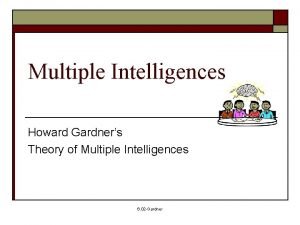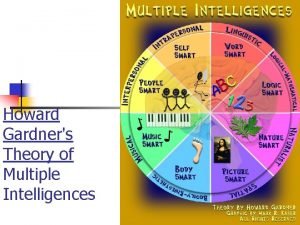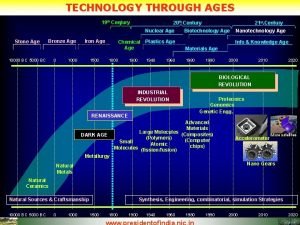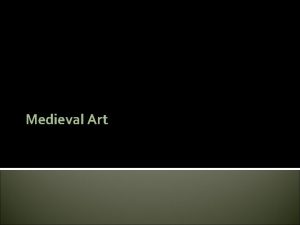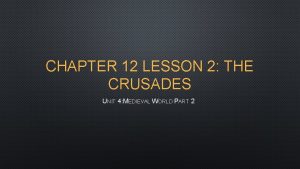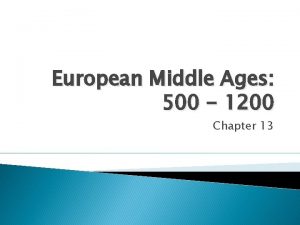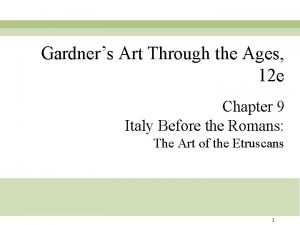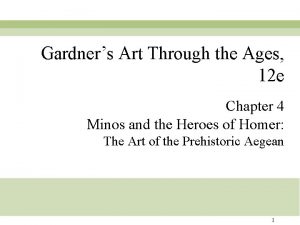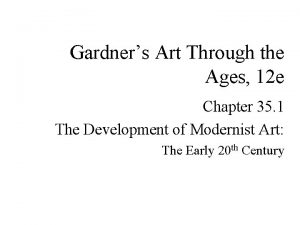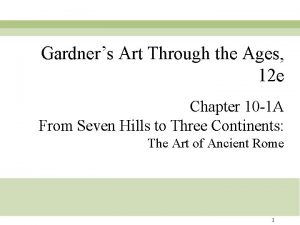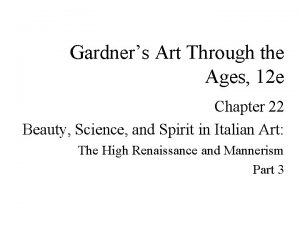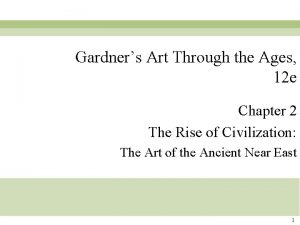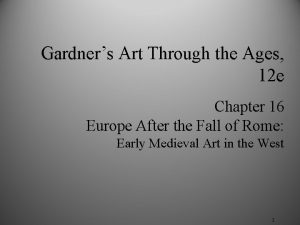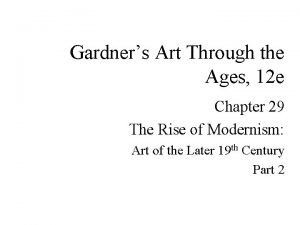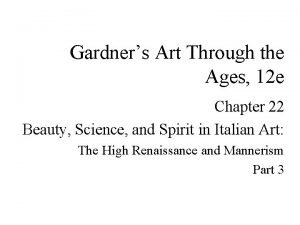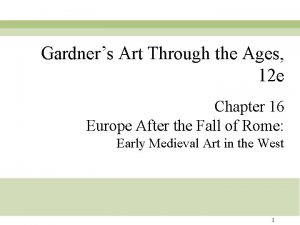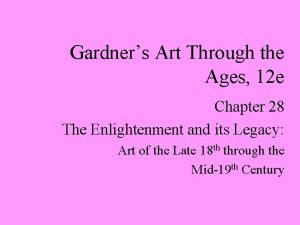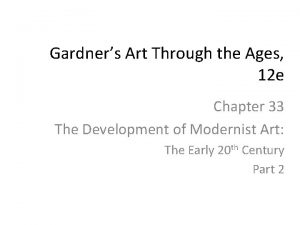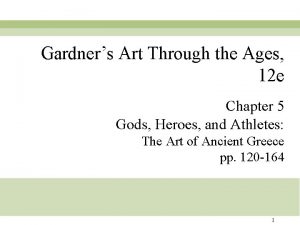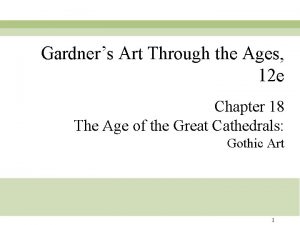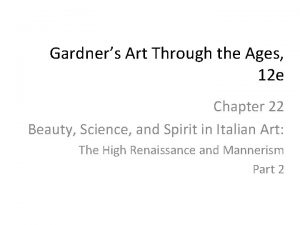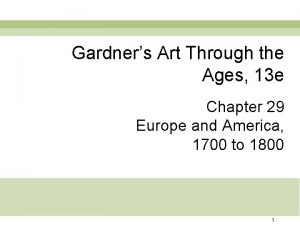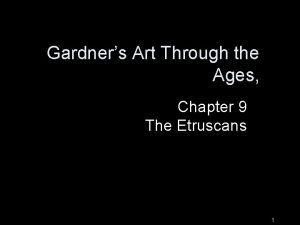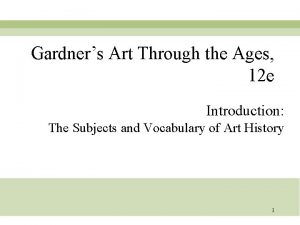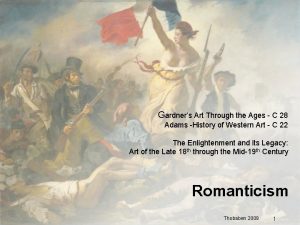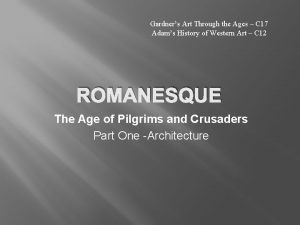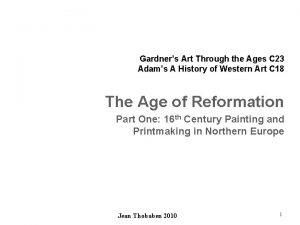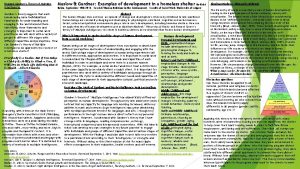Gardners Art Through the Ages 13 e Chapter
















































- Slides: 48

Gardner’s Art Through the Ages, 13 e Chapter 17 Romanesque Europe 1

Romanesque • “BUILD IT (BLOCK BY BLOCK) AND THEY WILL COME” • “BUILD IT”: ROMANESQUE ERA A TIME OF BUILDING CHURCHES IN WESTERN EUROPE • “BLOCK BY BLOCK”: STONE BLOCK BUILDING AND VAULTING, “BLOCKY” APPEARANCE OF ROMANESQUE ARCHITECTURE • THEY WILL COME”: PILGRIMAGES AND THEIR EFFECT ON THE LOCATION AND SIZE OF ROMANESQUE CHURCHES 2

• GENERAL GOALS: v UNDERSTAND THE TERM “ROMANESQUE” IN DESIGNATING THE ARTISTIC STYLE OF A HISTORIC PERIOD v ANALYZE CAUSE AND EFFECT RELATIONSHIPS AMONG PILGRIMAGES, CRUSADES, THE GROWTH OF URBAN CENTERS, ARCHITECTURAL INNOVATIONS, AND THE SIZE AND LOCATION OF CHURCHES v UNDERSTAND THE ‘MILLENNIAL’ APOCALYPTIC MOOD OF THE ROMANESQUE ERA AND IT’S EFFECT ON ARTISTIC THEMES v UNDERSTAND THE ROLE OF RELICS AND THE ARTISTIC OBJECTS DESIGNED TO CONTAIN RELICS 3

v RECOGNIZE CHANGES AND CONTINUITIES FROM PRIOR CIVILIZATIONS AND PERIODS IN ROMANESQUE ART AND ARCHITECTURE v RECOGNIZE DIFFERENCES AND SIMILARITIES IN REGIONAL ROMANESQUE ARCHITECTURE AND ARTISTIC STYLES. v UNDERSTAND THE NARRATIVE FUNCTION OF THE HUMAN FIGURE IN ROMANESQUE SCULPTURE. v KNOW AND USE RELEVANT ARTISTIC AND ARCHITECTURAL TERMINOLOGY 4

• TIMELINE v THE “ROMANESQUE ERA” = © 1050 – 1200 = A PERIOD IN ART HISTORY BASED ON ITS ARTISTIC AND ARCHITECTURAL STYLES v CONVENTIONAL HISTORICAL PERIODIZATION = THE BEGINNING OF THE HIGH MIDDLE AGES (INCLUDES THE GOTHIC ART HISTORY PERIOD, WHICH OVERLAPS WITH ROMANES QUE) v THE FOLLOWING TIMELINE = THE HISTORICAL CONTEXT OF THE ROMANESQUE ERA IN WESTERN EUROPEAN ART 5

v © 1000: Ø © 1000: BARBARIAN INVASIONS HAVE CEASED (VIKINGS ASSIMILATED), ALSO NO MAJOR WARS UNTIL CRUSADES ü FEUDALISM NO LONGER NECESSARY ü SAFER TO TRAVEL, TRADE REVIVES, CITIES ARISE, NEW TOWNS ALONG TRADE ROUTES ü LOTS OF SOLDIERS, NO WARS TO FIGHT Ø AGRICULTURAL REVOLUTION (STEEL PLOWS, HARNESSES, CROP ROTATION, WINDMILLS, SEED DRILLS MORE LAND UNDER CULTIVATION POPULATION BOOM (W. EUROPE POP. DOUBLED 1000 -1300) 6

v © 1050: Ø ü TRADE AND PILGRIMAGE ROUTES LINKED EUROPEAN REGIONS, CITIES, TOWNS TO EACH OTHER AND TO ASIA (AND NORTH AFRICA) MUCH CULTURAL DIFFUSION ü NEED FOR LARGE CHURCHES AT PILGRIMAGE SITES Ø TOO MANY UNOCCUPIED SOLDIERS, AND SURPLUS POPULATION DEVELOPING v 1054: GREAT SCHISM 7

Europe About 1100 8

• Pilgrimages: Cult of Relics • • Christians traveled to sacred sites that housed “relics” –objects associated with saints, martyrs, etc High point of pilgrimages in 11 th and 12 th centuries Set out on a journey for repentance or to heal themselves Saint Peters and Saint Paul’s in Rome-major shrines Others stayed closer to home visiting holy sites in France, Spain Provided revenues for the churches **POPULARITY OF PILGRIMAGES LED TO CHANGES IN CHURCH DESIGN – Longer & wider naves – Transepts and ambulatories with additional chapels – Second story galleries – Pilgrim routes established major trade routes in Europe 9

Romanesque in France 10

• Saint-Etienne, Vignory, France 10501057 fig 17 -1; 17 -2 11

• The capitals, like the arches, are all different shapes and sizes, and have abstract designs - but medieval sculptors just could not resist the odd little human face ! 12

• Interior of Saint. Philibert, Tournus, France, Nave vaults, ca. 1060, fig 17 -3 • • Transverse arches Barrel vaults Groin vaults Clerestory windows 13

Figure 17 -4 Aerial view (looking northwest) of Saint-Sernin, Toulouse, France, ca. 1070– 1120. 14

Figure 17 -5 Plan of Saint-Sernin, Toulouse, France, ca. 1070 -1120 (after Kenneth John Conant). 15

Interior of Saint-Sernin, Toulouse, France, ca. 1070 -1120, fig 17 -6 • Tribunes • Compound Piers • Springing 16

• Model of the third Abbey Church (Cluny III), Cluny, France, 10881130, Musee du Farinier, Cluny, fig 17 -7 17

Interior of abbey church of Notre-Dame, Fontenay, France, 11391147, fig 17 -8 18

Romanesque in Germany, Italy, and England 19

Figure 17 -19 Interior of Speyer Cathedral, Speyer, Germany, begun 1030; nave vaults, ca. 1082– 1105. 20

Interior and Aerial View of Sant’Ambrogio, Milan, Italy, late 11 th to early 12 th century, Fig 17 -10, fig 17 -11 21

Exterior and Interior of Saint. Etienne, Caen, France, begun 1067, ca. 1115 -1120 Fig 17 -12, Fig 17 -13 22

Durham Cathedral: interior (left), lateral section and plan (below), Durham, England, begun ca. 1093 Fig 17 -15, Fig-17 -16 23

Cathedral Complex, Pisa, Italy, cathedral begun 1063, baptistery begun 1153, campanile begun 1174, Fig 17 -17 24

Baptistery of San Giovanni, Florence, Italy, dedicated 1059 Fig 17 -18 25

San Miniato al Monte, Florence, Italy, ca. 1062 -1090 Fig 1719 26

ROMANESQUE SCULPTURE • Stone sculpture had almost disappeared from art of Western Europe during Middle ages –except monumental crosses of British Isles • Revival of stonecarving characteristic of Romanesque era-inspiration comes from Roman reliefs, sculptures • Individual motifs and designs come from Carolingian and Ottonian metalwork, illuminated manuscript and ivory carvings 27

Cloister of Saint-Pierre, Moissac, France, ca. 1001115, Limestone with marble relief panels, piers approx 6’ high, fig 17 -20 28

Bernardus Gelduinus, Christ in Majesty, relief in the ambulatory of Saint. Sernin, Toulouse, France, ca. 1096, Marble, 4’ 2” high, Fig 17 -21 29

Wiligelmo, creation and temptation of Adam and Eve, frieze on the west façade, Modena Cathedral, Modena, Italy, ca. 1110, Marble, approx 3’ high, Fig 17 -22 30

South portal of Saint-Pierre, Moissac, France ca. 1115 -1135 Fig 17 -23 31

The Romanesque Portal: page 463 32

Diagram of a Romanesque Portal Figure 17 -10 The Romanesque church portal. 33

Lions and Old Testament prophet (Jeremiah or Isaiah? ); trumeau of the south portal of Saint-Pierre, Moissac, France, ca. 1115 -1130; marble, life size, Fig 17 -24 . 34

Figure 17 -12 GISLEBERTUS, Last Judgment, west tympanum of Saint-Lazare, Autun, France, ca. 1120– 1135. Marble, 21’ wide at base. 35

Gislebertus, details, Last Judgment, Tympanum, Saint-Lazare, Autun, France, ca. 1120 -1135, marble, fig 17 -25 36

Ascension of Christ and Mission of the Apostles, tympanum of the center portal of the narthex of La Madeleine, Vezelay, France, ca. 1120 -1132, Fig 17 -26 37

Figure 17 -13 Pentecost and Mission of the Apostles, tympanum of the center portal of the narthex of La Madeleine, Vézelay, France, 1120– 1132. 38

Central portal, west façade, Saint-Trophime, Arles, France, mid 12 th century, Fig 17 -27 39

Benedetto Antelami, King David, statue in a niche on the west façade of Fidenza Cathedral, Fidenza, Italy ca. 1180 -1190, marble, life size, Fig 17 -28 40

Virgin and Child, (Morgan Madonna), from the Auvergne, France, second half of 12 th century, Painted wood, 2’ 7” high, Fig 17 -30 41

Head Reliquary of Saint Alexander, from Stavelot Abbey, Belgium, 1145. Silver Repousse, (some gilt), gilt bronze, gems, pearls, enamel, 1’ 5 ½” high, Fig 17 -31 42

PAINTING IN ROMANESQUE • • Painting of this period shows regional and stylistic diversity Painting of murals didn’t stop, many examples exist Large number in Catalonia, northern Spain (Islam did not reach here) Romanesque artists use fresco more than mosaic 43

Figure 17 -22 Hildegard receives her visions, detail of a facsimile of a lost folio in the Rupertsberger Sciviasby Hildegard of Bingen, from Trier or Bingen, Germany, ca. 1150– 1179. Abbey of St. Hildegard, Rüdesheim/Eibingen. 44

Initial R with knight fighting dragon, folio 4 of the Moralia in Job, Citeaux, France ca. 1115 -1125, ink and tempera on vellum, 1’ 1 ¾” x 9 ¼” Fig 17 -36 45

Figure 17 -37 EADWINE THE SCRIBE, Eadwine the scribe at work, folio 283 verso of the Eadwine Psalter, ca. 1160 – 1170. Ink and tempera on vellum. Trinity College, Cambridge. 46

Figure 17 -35 Funeral procession to Westminster Abbey (top) and Battle of Hastings (bottom), details of the Bayeux Tapestry, from Bayeux Cathedral, Bayeux, France, ca. 1070 -1080. Embroidered wool on linen, 1’ 8” high (entire length of fabric 229’ 8”). Centre Buillaume le Conquerant, Bayeux. 47

• • http: //www. youtube. com/watch? v=Al. Ht. V_xe 5 FY&lr=1 Romanesque video 48
 Howard gardners theory of multiple intelligences
Howard gardners theory of multiple intelligences Multiple intelligences
Multiple intelligences Dark ages vs middle ages
Dark ages vs middle ages Dark ages vs middle ages
Dark ages vs middle ages Chapter 7 early childhood ages 3 through 5
Chapter 7 early childhood ages 3 through 5 Literary archetypes
Literary archetypes Technology through the ages
Technology through the ages Art of emerging europe example
Art of emerging europe example Middle ages art characteristics
Middle ages art characteristics Chapter 12 lesson 4 the late middle ages
Chapter 12 lesson 4 the late middle ages The great schism
The great schism Through one man
Through one man Furcation involvement classification
Furcation involvement classification What is timber conversion
What is timber conversion Night of the scorpion images
Night of the scorpion images Hình ảnh bộ gõ cơ thể búng tay
Hình ảnh bộ gõ cơ thể búng tay Ng-html
Ng-html Bổ thể
Bổ thể Tỉ lệ cơ thể trẻ em
Tỉ lệ cơ thể trẻ em Gấu đi như thế nào
Gấu đi như thế nào Chụp phim tư thế worms-breton
Chụp phim tư thế worms-breton Chúa sống lại
Chúa sống lại Các môn thể thao bắt đầu bằng tiếng chạy
Các môn thể thao bắt đầu bằng tiếng chạy Thế nào là hệ số cao nhất
Thế nào là hệ số cao nhất Các châu lục và đại dương trên thế giới
Các châu lục và đại dương trên thế giới Công thức tính thế năng
Công thức tính thế năng Trời xanh đây là của chúng ta thể thơ
Trời xanh đây là của chúng ta thể thơ Cách giải mật thư tọa độ
Cách giải mật thư tọa độ Phép trừ bù
Phép trừ bù độ dài liên kết
độ dài liên kết Các châu lục và đại dương trên thế giới
Các châu lục và đại dương trên thế giới Thơ thất ngôn tứ tuyệt đường luật
Thơ thất ngôn tứ tuyệt đường luật Quá trình desamine hóa có thể tạo ra
Quá trình desamine hóa có thể tạo ra Một số thể thơ truyền thống
Một số thể thơ truyền thống Cái miệng xinh xinh thế chỉ nói điều hay thôi
Cái miệng xinh xinh thế chỉ nói điều hay thôi Vẽ hình chiếu vuông góc của vật thể sau
Vẽ hình chiếu vuông góc của vật thể sau Nguyên nhân của sự mỏi cơ sinh 8
Nguyên nhân của sự mỏi cơ sinh 8 đặc điểm cơ thể của người tối cổ
đặc điểm cơ thể của người tối cổ Thế nào là giọng cùng tên
Thế nào là giọng cùng tên Vẽ hình chiếu đứng bằng cạnh của vật thể
Vẽ hình chiếu đứng bằng cạnh của vật thể Fecboak
Fecboak Thẻ vin
Thẻ vin đại từ thay thế
đại từ thay thế điện thế nghỉ
điện thế nghỉ Tư thế ngồi viết
Tư thế ngồi viết Diễn thế sinh thái là
Diễn thế sinh thái là Dạng đột biến một nhiễm là
Dạng đột biến một nhiễm là So nguyen to
So nguyen to Tư thế ngồi viết
Tư thế ngồi viết
